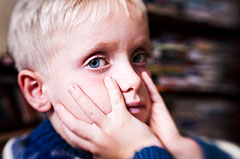
 Autism is a common developmental disorder that involves problems with social interaction, communication and unusual activities and interests. It is part of a group of conditions known as autism spectrum disorders that usually appear before the age of three. Autism affects four times as many boys than girls.
Autism is a common developmental disorder that involves problems with social interaction, communication and unusual activities and interests. It is part of a group of conditions known as autism spectrum disorders that usually appear before the age of three. Autism affects four times as many boys than girls.
The symptoms of autism are classified into problems with social interaction, language and behavior. Social interaction symptoms usually present themselves first and can include:
- Poor eye contact
- Doesn't respond to his or her name
- Focusing on one item and blocks out everything else
- Unaware of the feelings of others
- Prefers to play alone
These symptoms can be detected as early as infancy. Language and behavior symptoms can include:
- Starts talking later than others
- May speak in a singsong voice or other abnormal rhythm
- Can't start a conversation
- Talks only about a select few topics
- Performs repetitive movements like rocking, spinning or hand-flapping
- Resistant to change
- Constantly moving
- Sensitive to touch or sound but oblivious to pain
The specific cause of autism is not known, but is believed to be a combination of genetic and environmental factors. Signs of delayed development usually present themselves by 18 months. It is important to speak to your doctor if you think your child is showing signs of autism. Early treatment is often more effective.
Symptoms of autism usually improve with age and effective treatment methods. Treatment for autism typically includes medication, therapy and behavioral interventions. Your doctor will help you decide which treatment option is best for your child.
Learning Disabilities
 A learning disability is a neurological condition that prevents a child from learning or significantly impairs the learning process. Although the child may have average or higher intelligence, he or she has a much lower ability to learn in one or more academic areas. Learning disabilities are believed to be a result of neurological processing problems, although heredity and birth defects may also be involved. A child's risk of having a learning disability is increased when a parent or other relative also has one.
A learning disability is a neurological condition that prevents a child from learning or significantly impairs the learning process. Although the child may have average or higher intelligence, he or she has a much lower ability to learn in one or more academic areas. Learning disabilities are believed to be a result of neurological processing problems, although heredity and birth defects may also be involved. A child's risk of having a learning disability is increased when a parent or other relative also has one.
Learning disabilities are diagnosed by assessing a child's IQ score and achievement test scores in certain subject areas, such as reading, math and writing. Children may also have disabilities concerning listening and oral skills.
The best protection against learning disabilities is through early detection. Parents should seek medical attention for their child if they notice developmental delays involving the child's gross or fine motor skills, speech or cognitive skills. As the child enters school, parents should meet with the child's teacher and discuss any concerns they may have.
If a learning disability is diagnosed, a special learning program, called an Individualized Education Program (IEP), will be designed for the child to follow at school and at home. Medication may be prescribed for children with Attention Deficit Hyperactivity Disorder (ADHD) in order to help them improve their attention span and ability to focus. Although there is no cure for learning disabilities, most patients learn to adapt to their differences and are still able to accomplish their academic goals.
Seizures and Epilepsy
Epilepsy is a neurological condition that causes certain nerve cells in the brain to send abnormal signals, which result in strange body behaviors known as seizures. Epileptic seizures can cause muscle spasms, convulsions and other troubling symptoms at any time.
Seizures caused by epilepsy are unprovoked by other medical conditions and have occurred at least twice in order to properly diagnose the condition. The cause of these seizures cannot be identified, but is believed to be a result of problems with the brain's wiring or high levels of neurotransmitters.
When your child experiences a seizure, he or she may experience a wide range of symptoms depending on the type and severity of the seizure. Some of these symptoms may include:
- Staring
- Jerking movements
- Stiffening
- Loss of consciousness
- Nodding the head
- Rapid eye blinking
It is important to monitor the symptoms of your child's seizures so that the doctor can more easily diagnose this condition. Several tests, including blood tests, MRI, CT scan and a spinal tap may be performed in order to diagnose epilepsy.
Although epilepsy is a chronic condition with no cure, most cases can be effectively managed through medication and surgery if necessary. A special diet, known as a ketogenic diet, may be recommended for patients who do not respond well to medication. It is important to begin treatment as soon as possible in order to minimize the frequency and severity of seizures. Many patients experience complete relief from symptoms over time.
Muscle Disorders
Muscle disorders, also known as myopathy, are a series of conditions that cause muscle dysfunction resulting in weakness, deterioration and even paralysis. These conditions can be inherited or acquired, and may be present at birth or develop later on.
The cause of muscle disorders is often unknown, although they may develop from:
- Injury
- Overuse
- Genetics
- Cancer
- Inflammation
- Infection
- Reaction to medication
Muscular dystrophy is one of the most common types of muscle disorder that affects children. This genetic condition is present at birth, although symptoms do not usually begin until the child is a few years old. Muscular dystrophy may cause children to stumble, waddle and have trouble standing up and pushing things. Symptoms may vary depending on the individual type of muscular dystrophy.
Congenital myopathies are present at birth and usually caused by hereditary factors, but are not considered progressive. These conditions often affect the legs and cause a delayed ability to walk or trouble climbing stairs.
Inflammatory myopathies are muscle disorders that are a result of an immune system reaction in the muscles. These autoimmune disorders attack the body cells and causes overall muscle weakness. Drug-induced myopathy is caused from the use of certain medications, such as immunosuppressants, and can cause severe weakness in some cases
Although muscle disorders usually cannot be cured, there are several treatment options available to manage the symptoms of the disorders and maximize your child's quality of life. Treatment for muscle disorders may include physical therapy, bracing, anti-inflammatory medication or walking devices. More severe cases may require surgery to release tendons or correct abnormalities of the spine.
Cerebral Palsy
Cerebral palsy is a neurological condition that causes problems with body movement and muscle coordination throughout a child's life. While most children are born with this condition, signs may not appear until months or years later. If you notice your child having trouble sitting, crawling or walking, he or she may have cerebral palsy.
Cerebral palsy affects the central nervous system and may occur as a result of several different causes. In most cases, the condition develops during the pregnancy, but may also be a result of complications with delivery. Some of the risk factors for cerebral palsy include:
- Premature birth
- Brain infections
- Genetic disorders
- Stroke
- Improper brain development
- Lack of oxygen to the brainÂ
There are four main types of cerebral palsy, which can be diagnosed once the child is about two years old. These types include:
- Spastic - causes increased muscle tone and tightness throughout the legs, arms and back (most common type)
- Athetoid - causes low muscle tone and looseness in the entire body
- Ataxic - affects balance and depth perception, leading to overall poor coordination
- Mixed - includes symptoms of spastic and athetoid, causing stiffness and involuntary movements
Although there is no cure for cerebral palsy, there are several treatments available to help relieve the symptoms of this condition and improve your child's physical capabilities. Many children with this condition are able to go on and enjoy functional, independent adult lives. Treatment for cerebral palsy may include physical, occupational and speech therapy, and medications to help control seizures, relax muscle spasms and relieve pain. Surgery may be required to correct structural abnormalities or release tight muscles.
Other treatment options for cerebral palsy include:
- Braces
- Splints
- Casts
- Communication devices
- Botox (to loosen spastic muscles)
Through continued treatment, most children are able to improve their motor skills and communicate to lead a life that is as close to normal as possible.


